Journal Description
Veterinary Sciences
Veterinary Sciences
is an international, peer-reviewed, open access journal on veterinary sciences published monthly online by MDPI.
- Open Access— free for readers, with article processing charges (APC) paid by authors or their institutions.
- High visibility: indexed within Scopus, SCIE (Web of Science), PubMed, PMC, Embase, PubAg, AGRIS, and other databases.
- Journal Rank: JCR - Q2 (Veterinary Sciences) / CiteScore - Q2 (General Veterinary)
- Rapid Publication: manuscripts are peer-reviewed and a first decision is provided to authors approximately 21.2 days after submission; acceptance to publication is undertaken in 2.7 days (median values for papers published in this journal in the second half of 2024).
- Recognition of Reviewers: reviewers who provide timely, thorough peer-review reports receive vouchers entitling them to a discount on the APC of their next publication in any MDPI journal, in appreciation of the work done.
Impact Factor:
2.0 (2023);
5-Year Impact Factor:
2.2 (2023)
Latest Articles
No Genomic Signatures Were Found in Escherichia coli Isolates from Camels With or Without Clinical Endometritis
Vet. Sci. 2025, 12(5), 457; https://doi.org/10.3390/vetsci12050457 (registering DOI) - 10 May 2025
Abstract
Clinical endometritis is a leading cause of infertility in she-camels. We commonly isolate E. coli from camel uteri with and without endometritis during our routine diagnosis of conception failure. From an epidemiological standpoint, it is critical to know if certain E. coli genotypes
[...] Read more.
Clinical endometritis is a leading cause of infertility in she-camels. We commonly isolate E. coli from camel uteri with and without endometritis during our routine diagnosis of conception failure. From an epidemiological standpoint, it is critical to know if certain E. coli genotypes and virulence factors are specifically associated with endometritis. Thus, we aimed to compare the abundance of virulence elements and genotypes in uterine E. coli from camels with and without endometritis and understand their evolution. For this investigation, we retrieved data from the genomes of 28 E. coli isolates from humans, cats, dogs, horses, cows, and birds and 14 sequenced genomes of camel uterine E. coli isolates. We found no specific E. coli genotype or virulence factor associated with endometritis. Instead, multiple genotypes and high genomic diversity were observed. Moreover, horizontal gene transfer driven by genomic islands and plasmids contributed to the genetic diversity of the isolates, resulting in the acquisition of virulence genes, metabolic characteristics, and antibiotic resistance determinants to trimethoprim, sulfonamide, streptomycin, and tetracycline. Additionally, the phylogenetic position of the E. coli isolates from camel uteri suggests that they originated from intestinal strains. In conclusion, there was no evidence of E. coli specialization, and E. coli alone may not be able to develop endometritis, as other factors are required. Also, we elucidated the mechanism behind the diversity of the gene repertoire of E. coli isolated from camel uteri. These findings provide insight into the evolutionary origins of E. coli isolates from camel uteri.
Full article
(This article belongs to the Special Issue Advances in Veterinary Clinical Microbiology)
►
Show Figures
Open AccessStudy Protocol
Otogenic Meningitis or Meningoencephalitis in 30 Dogs: Association Between Neurological Signs, Magnetic Resonance Imaging Findings, and Outcome
by
Meritxell Moral, Carlos Blanco and Valentina Lorenzo
Vet. Sci. 2025, 12(5), 456; https://doi.org/10.3390/vetsci12050456 - 9 May 2025
Abstract
►▼
Show Figures
This retrospective study aimed to assess the accuracy of neurological examination in identifying intracranial extension of ear infection in dogs and to investigate the clinical data that may potentially aid in its diagnosis and prognosis. Dogs diagnosed with meningitis or meningoencephalitis due to
[...] Read more.
This retrospective study aimed to assess the accuracy of neurological examination in identifying intracranial extension of ear infection in dogs and to investigate the clinical data that may potentially aid in its diagnosis and prognosis. Dogs diagnosed with meningitis or meningoencephalitis due to an intracranial extension of otitis media-interna were included, and the relationship of MRI findings with neurological examination, clinical data, and outcome was studied. Thirty dogs were included, with 96% corresponding to brachycephalic breeds and a mean age of 7.5 years. The neurological examination was accurate in localizing the lesion in the central nervous system in 33% of dogs. Dogs with brainstem parenchymal involvement in magnetic resonance imaging (MRI) had a longer recovery (21 days). Recovery was complete in 28% of cases, with dogs more likely to have persistent neurological deficits when parenchymal and/or meningeal involvement was observed on imaging. MRI did not show intracranial extension in 20% of cases despite inflammatory cerebrospinal fluid (CSF). This study supports the conclusion that intracranial extension of otogenic infection is possible in dogs without central nervous system signs. When otitis media-interna is diagnosed, MRI and CSF studies should be recommended, especially for chronic or recurrent cases and in brachycephalic breeds.
Full article
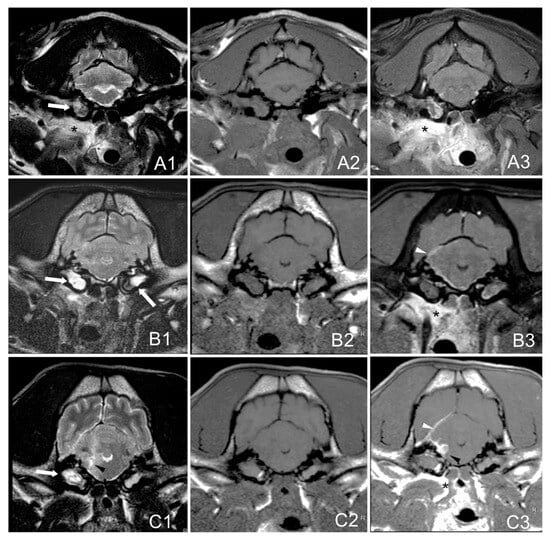
Figure 1
Open AccessArticle
Molecular Evidence of SARS-CoV-2 Virus in Dogs and Cats from Grenada
by
Vanessa Matthew-Belmar, Trevor Noel, Bhumika Sharma, Katherine Yearwood, Paul Fields, Wayne Sylvester, Nandy Noel, Elsa Chitan, Nikita Cudjoe, Veronica Alexander, Christopher Oura, Calum Macpherson and Andy Alhassan
Vet. Sci. 2025, 12(5), 455; https://doi.org/10.3390/vetsci12050455 - 9 May 2025
Abstract
SARS-CoV-2 is a highly contagious virus that infects humans, wildlife, domesticated and farmed animals. An increase in SARS-CoV-2 variants and human–animal interactions could have implications for the global maintenance and perpetuation of the virus. This study aimed to detect SARS-CoV-2 infection in dogs
[...] Read more.
SARS-CoV-2 is a highly contagious virus that infects humans, wildlife, domesticated and farmed animals. An increase in SARS-CoV-2 variants and human–animal interactions could have implications for the global maintenance and perpetuation of the virus. This study aimed to detect SARS-CoV-2 infection in dogs and cats living in households with and without SARS-CoV-2-positive owners by real-time reverse transcription polymerase chain reaction (qRT-PCR) in Grenada. This cross-sectional study was conducted from August 2020 to April 2022 from dogs (139) and cats (22) in households (96) in Grenada. Nasopharyngeal and oropharyngeal swabs were taken from the dogs and cats to detect SARS-CoV-2. qRT-PCR tests were performed targeting the E and RdRP genes, respectively. Notably, 12% (17/139) of dogs and 23% (5/22) of cats tested positive for SARS-CoV-2. The positive animals were found in 17 (18%) households, all with at least one positive individual. No positive cases of pets were detected in households without infected humans. A statistically significant association (p < 0.0001) was observed between humans with SARS-CoV2 and their pets. Phylogenetic tree analysis showed evidence of a relationship between the Grenadian SARS-CoV-2 E gene and other SARS-CoV-2 E gene sequences available in the NCBI database. This study confirmed the concurrent SARS-CoV-2 human/companion animal infection from households in Grenada. Humans and pet animals were positive synchronously; however, the direction of transmission from pets to humans or vice versa remains unknown. This study suggests that pets could play a role in the maintenance, transmission, and prolongation of infection of human-adapted pathogens such as SARS-CoV-2.
Full article
(This article belongs to the Special Issue Viral Infections in Wild and Domestic Animals)
►▼
Show Figures
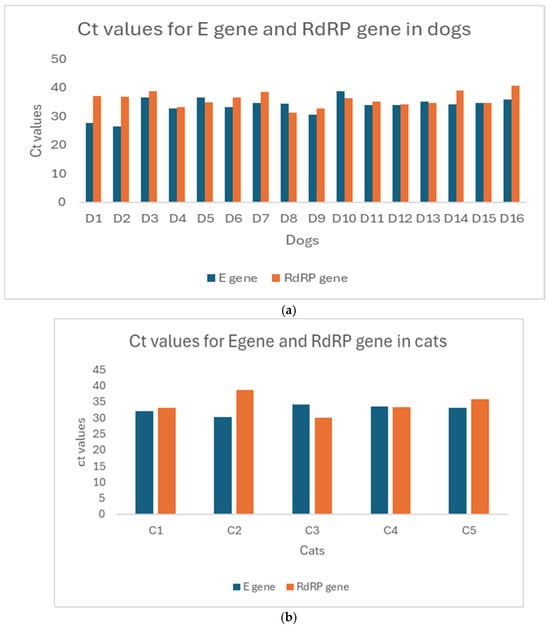
Figure 1
Open AccessArticle
Hematology and Plasma Biochemistry Reference Values of the Subgenus Hapturosaurus (Varanus macraei, Varanus prasinus, Varanus beccarii) Under Human Care
by
Jorge Sobrino-Yacobi, Manuel Fuertes-Recuero, Manuel de la Riva-Fraga, Teresa Encinas Cerezo, Andrés Montesinos Barceló, Álvaro Camina Vega and Pablo Morón-Elorza
Vet. Sci. 2025, 12(5), 454; https://doi.org/10.3390/vetsci12050454 - 9 May 2025
Abstract
The tree monitor lizards of the subgenus Hapturosaurus are an understudied but increasingly important group of reptiles in zoos. The routine blood analysis of reptiles in captivity is highly recommended; however, the lack of reliable reference values for many species severely limits their
[...] Read more.
The tree monitor lizards of the subgenus Hapturosaurus are an understudied but increasingly important group of reptiles in zoos. The routine blood analysis of reptiles in captivity is highly recommended; however, the lack of reliable reference values for many species severely limits their clinical use. This study aims to establish preliminary reference values (RV) for the main hematological and biochemical parameters in three species of the subgenus Hapturosaurus (Varanus macraei, Varanus prasinus and Varanus beccarii). Blood samples were taken from healthy adult individuals (n = 34), females (n = 18) and males (n = 16), maintained under controlled conditions in a zoo. A complete biochemical analysis was performed on all individuals, including alanine-aminotransferase, alkaline phosphatase, gamma-glutamyl transpeptidase, aspartate-aminotransferase, creatine kinase, bile acids, urea, uric acid, total solids, total proteins, albumin, glucose, fructosamine, lactate, cholesterol, triglycerides, amylase, calcium, phosphorus, calcium:phosphorus ratio, and magnesium. In addition, a complete hematological analysis was conducted on these individuals, including hematocrit, hemoglobin concentration, total erythrocyte and leukocyte counts, and leukocyte differential count. From the data obtained, reference intervals were established following the guidelines provided by the American Society for Veterinary Clinical Pathology (ASVCP). In this study, the results of the three species were unified to increase the sample size and to obtain more representative reference intervals. This unification was supported by a statistical analysis using the one-factor ANOVA test, which showed no statistically significant differences between species (p < 0.050). These data constitute an essential first step for the clinical practice and management of these Hapturosaurus species in zoos and specialized centers. Future collaboration with other institutions will help expand the dataset and enhance the accuracy of the established reference values.
Full article
(This article belongs to the Section Veterinary Physiology, Pharmacology, and Toxicology)
►▼
Show Figures

Figure 1
Open AccessReview
Systemic Arterial Hypertension and Factors Associated with Blood Pressure Dysregulation in Companion Animals
by
Felipe Gaia de Sousa, Fabiana Silva Fádel Queiroz, Ruthnéa Aparecida Lázaro Muzzi, Júlio César Cambraia Veado and Suzane Lilian Beier
Vet. Sci. 2025, 12(5), 453; https://doi.org/10.3390/vetsci12050453 - 9 May 2025
Abstract
Systemic arterial hypertension (SAH), characterised by a persistent increase in BP beyond the reference values for the species, is a concerning and detrimental clinical condition. The aim of this manuscript is to present the state of the art on SAH in companion animals,
[...] Read more.
Systemic arterial hypertension (SAH), characterised by a persistent increase in BP beyond the reference values for the species, is a concerning and detrimental clinical condition. The aim of this manuscript is to present the state of the art on SAH in companion animals, including the different types of hypertension, diagnostic and therapeutic approaches, and the factors associated with its occurrence, such as the role of stress. It also discusses the benefits and challenges related to the measurement process. SAH is categorised into types based on the underlying cause: situational, secondary, and idiopathic (the least frequently observed). The situational type occurs when stress is the primary factor, such as during veterinary visits, contact with other animals, or in cases of ‘white coat syndrome’. If the stressor is removed, BP values tend to normalise. The most common type of SAH is the secondary form, which is associated with an underlying condition, such as renal, cardiac, endocrine, or neurological diseases, or a combination of these. Diagnosing SAH is a challenging task for many veterinarians due to factors related to handling the animal, managing the equipment, and interpreting the results. Consequently, many professionals either take inaccurate measurements or misinterpret the results, often prescribing antihypertensive medications prematurely or unnecessarily. Despite being a well-standardised and well-documented process, challenges persist. Treatment often involves antihypertensive drugs, either alone or in combination, alongside management of the underlying causes, when present. Therefore, BP values should be obtained correctly, with clinical-therapeutic decisions carefully aligned with the factors that may influence them.
Full article
(This article belongs to the Special Issue Advances in Companion Animal Cardiology: Diagnostic and Therapeutic Approaches)
►▼
Show Figures
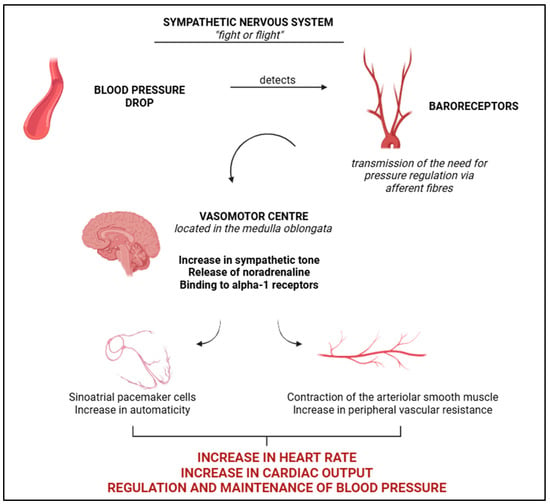
Figure 1
Open AccessArticle
Analytical Evaluation of Three Portable Blood Glucose Meters for Human Use in Dogs
by
José Lucas Xavier Lopes, Taís Bock Nogueira, Luana Rodrigues, Vitória Strzeleski Wodzik, Denise Iparraguirre da Silva, Bruna dos Santos Machado and Álan Gomes Pöppl
Vet. Sci. 2025, 12(5), 452; https://doi.org/10.3390/vetsci12050452 - 9 May 2025
Abstract
►▼
Show Figures
Portable blood glucose meters (PBGMs) are essential for detecting glycemic disorders. In Brazil, veterinary devices are scarce, and human devices are used as an alternative. This study evaluated the accuracy of three human glucometers: Accu-Chek Guide® (ACG), Accu-Chek Guide Me® (ACGM)
[...] Read more.
Portable blood glucose meters (PBGMs) are essential for detecting glycemic disorders. In Brazil, veterinary devices are scarce, and human devices are used as an alternative. This study evaluated the accuracy of three human glucometers: Accu-Chek Guide® (ACG), Accu-Chek Guide Me® (ACGM) (Roche), and EcoCheck® (EC) (Eco Diagnóstica). A total of 419 glycemic samples were collected and compared to the glucose oxidase method (GOM), which is considered to be the gold standard. Despite a strong positive correlation compared to the GOM (ACG r = 0.96; ACGM r = 0.9; EC r = 0.89; p < 0.0001), when evaluated by the criteria defined by ISO 15197:2013 for analytical precision, no PG obtained 99% of the readings within the range of +/− 15 for glucose levels < 100 mg/dL and +/− 15% for glucose levels > 100 mg/dL (ACG = 57.9%, ACGM = 47.9%, and EC = 28.4%). ACG was the only PG that fully met the clinical precision criteria according to ISO 15197:2013, with 100% of its measurements in Zones A+B of the error grid. Despite analytical inaccuracy, the ACG PBGM proved to be the best among the devices tested in this study for use in dogs with whole blood samples, not generating any negative impact on animal health.
Full article

Figure 1
Open AccessArticle
Use of Fermented Black Tea (Camellia sinensis) Factory Wastes in Standard Rat Diets
by
Buğra Genç, Nilüfer Kuruca, Gül Fatma Yarım, Tolga Güvenç, Emre Özan, Bahadır Müftüoğlu, Tayfun İde, Aşkın Nur Derinöz Erdoğan and Serdar Odacı
Vet. Sci. 2025, 12(5), 451; https://doi.org/10.3390/vetsci12050451 - 8 May 2025
Abstract
Although there are studies on the use of different tea extracts in animal diets, there are no studies on the use of fermented black tea factory production waste (FTFW) in rodent diets. This study aims to evaluate the effects of FTFW, considered an
[...] Read more.
Although there are studies on the use of different tea extracts in animal diets, there are no studies on the use of fermented black tea factory production waste (FTFW) in rodent diets. This study aims to evaluate the effects of FTFW, considered an environmentally hazardous waste, in standard rat diets regarding nutritional, histopathological, and biochemical parameters. In this study, 40 male Wistar albino rats (70 days old, with a live weight of 200–250 g) were divided into four groups, each containing 10 rats. They were fed standard rat diets for 63 days, with varying amounts (0%, 3%, 5%, and 10%) of tea production waste. At the end of the experiment, biochemical analysis of blood and histopathological analysis of all organs were performed. There was no significant difference between the groups in terms of body weight, internal organ weights, or serum biochemical parameters (p > 0.05). No pathological findings were observed in any of the groups. The group receiving 10% tea waste, which had the highest total polyphenol level (1.42 ppm), also showed the highest serum total antioxidant status (TAS) (p < 0.05). In contrast, this group had the lowest total oxidant status (TOS) and oxidative stress index (OSI) levels (p < 0.05). The study concluded that FTFW can be included in the pellet diet of rats without changing their general health status and that a potential environmental pollutant can be used in rat diets.
Full article
(This article belongs to the Special Issue Medical Interventions in Laboratory Animals)
►▼
Show Figures
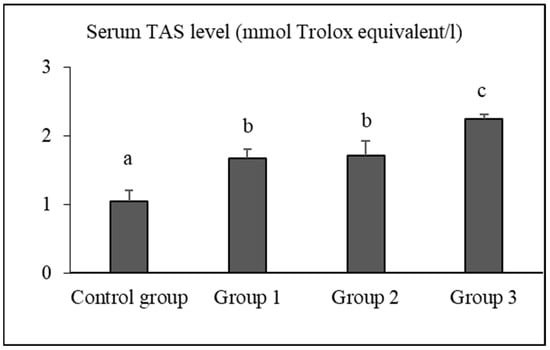
Figure 1
Open AccessBrief Report
Establishment of a TaqMan Quantitative Real-Time PCR for Detecting Lawsonia intracellularis
by
Zhiqiang Hu, Ranran Lai, Wei Xu, Ran Guan, Zhimin Zhang, Guangwen Yan and Guiying Hao
Vet. Sci. 2025, 12(5), 450; https://doi.org/10.3390/vetsci12050450 - 8 May 2025
Abstract
Porcine proliferative enteropathy (PPE) is an infectious disease in pigs, caused by Lawsonia intracellularis (LI), affecting their intestines during growth and finishing stages, leading to higher production costs. Current detection methods for LI face two main challenges, delayed results and high costs, making
[...] Read more.
Porcine proliferative enteropathy (PPE) is an infectious disease in pigs, caused by Lawsonia intracellularis (LI), affecting their intestines during growth and finishing stages, leading to higher production costs. Current detection methods for LI face two main challenges, delayed results and high costs, making them impractical for large-scale pig farming epidemiological surveys. This study developed a TaqMan-qPCR method using specific probes and primers based on the LI aspartate ammonia lyase genes from GenBank, completing detection in just 45 min. After optimizing reaction conditions, sensitivity analysis revealed that the detection limit of this method was 4.6 copies/μL targeting standard plasmids. The results of the specificity analysis showed no cross-reactivity with other common porcine pathogens, highlighting its specificity. The inter- and intra-group coefficients of variation were both <1%, indicating high reproducibility. Furthermore, the TaqMan-qPCR demonstrated 100% relative sensitivity, and a 92.50% compliance rate compared to conventional PCR, suggesting it could be a complement to the conventional PCR method. In summary, the TaqMan-qPCR method established in this study is not only suitable for epidemiological investigations and early qualitative and quantitative diagnosis of proliferative enteropathy in pigs, but it is also valuable for studying the biological characteristics of LI.
Full article
(This article belongs to the Special Issue Emerging Bacterial Pathogens in Veterinary Medicine)
►▼
Show Figures
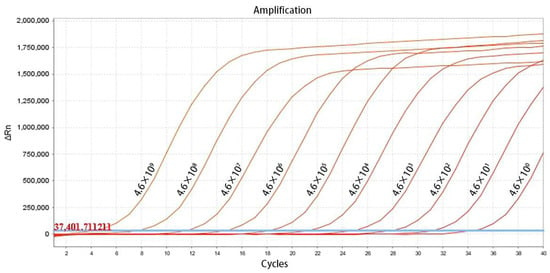
Figure 1
Open AccessReview
Influence of Probiotic Administration in Canine Feed: A Comprehensive Review
by
Niranjana Karukayil Gopalakrishnan, Manikantan Pappuswamy, Gomathy Meganathan, Sureshkumar Shanmugam, Karthika Pushparaj, Balamuralikrishnan Balasubramanian and In Ho Kim
Vet. Sci. 2025, 12(5), 449; https://doi.org/10.3390/vetsci12050449 - 7 May 2025
Abstract
Dogs are cherished companions, and in today’s world, pets are increasingly regarded as family members. Pet owners are placing growing emphasis on their animals’ health, particularly for dogs. Probiotics, which are living bacteria that benefit the host when given in sufficient quantities, have
[...] Read more.
Dogs are cherished companions, and in today’s world, pets are increasingly regarded as family members. Pet owners are placing growing emphasis on their animals’ health, particularly for dogs. Probiotics, which are living bacteria that benefit the host when given in sufficient quantities, have drawn a lot of interest in the veterinary nutrition community due to their beneficial effects on companion animals, including dogs. This study emphasizes the advantages of adding probiotics to canine diets in order to enhance the health of the gut flora and the technologies used to incorporate probiotics into canine feed. It looks at the best ways to deal with common dog health problems, highlighting probiotics as a helpful substitute for antibiotics, which can have serious adverse effects, encourage bacterial resistance, and disturb the gut’s microbial ecology, which is necessary for digesting. Such disruptions are linked to chronic inflammatory enteropathy and obesity in dogs. This paper also examines biotechnological advancements in probiotic incorporation methods in dog feed, aiming to optimize their health benefits. Probiotic feed supplements may thus represent a promising approach to advancing canine health care, providing a natural adjunct to conventional treatments and preventive measures.
Full article
(This article belongs to the Section Nutritional and Metabolic Diseases in Veterinary Medicine)
►▼
Show Figures
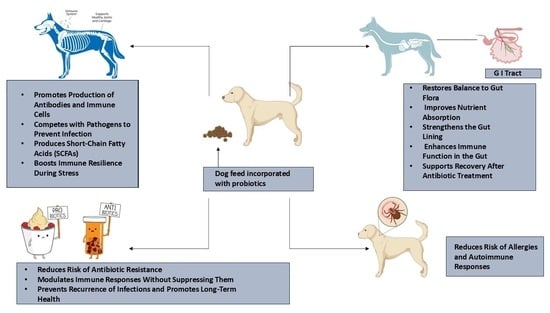
Graphical abstract
Open AccessArticle
Risk Factors and Spatial Distribution of Gastrointestinal Parasites in Backyard Poultry Production Systems in Central Chile
by
Bruno Cantin-Rosas, Mariela Luján Tomazic, Anabel Elisa Rodríguez, Nikita Enciso, Juliette Brante-Bernier, Patricia Honores, Catalina Godoy-Alfaro, Claudio Abarca, Raúl Alegría-Morán and Galia Ramirez-Toloza
Vet. Sci. 2025, 12(5), 448; https://doi.org/10.3390/vetsci12050448 - 7 May 2025
Abstract
Gastrointestinal parasites impact the health and productivity of domestic birds and may even be more common in production systems with lower biosafety conditions. In this context, backyard poultry production systems (BPPS), defined as small-scale family production systems, could be more affected. However, information
[...] Read more.
Gastrointestinal parasites impact the health and productivity of domestic birds and may even be more common in production systems with lower biosafety conditions. In this context, backyard poultry production systems (BPPS), defined as small-scale family production systems, could be more affected. However, information about its epidemiology is limited in the Central Zone of Chile. This study aimed to determine the risk factors and spatial distribution of gastrointestinal parasites in BPPS in Central Chile. Thus, feces samples were collected from 51 backyards and analyzed using copro–parasitological techniques. In parallel, an epidemiological survey was conducted on the farmers, and the data were analyzed by multivariable logistic regression to identify risk factors. Spatial analysis was performed with the detected parasite species to determine high-risk clusters. Eimeria spp. was the most frequently detected parasite (72.5%), followed by Capillaria spp. (50.9%) and Ascaridia galli (49%). Regarding parasitic burden, nearly 90% of BPPS showed low parasitic burden for Eimeria spp. and helminths. In turn, the availability of potable drinking water (95% CI: 0.054–0.905; p = 0.036) and proper ventilation of the pens (95% CI: 0.003–0.429; p = 0.009) reduced the presence of parasites. Spatial high-risk clusters were detected for Eimeria spp. (RR = 2.60; p-value < 0.0001), A. galli (RR = 2.93; p-value = 0.021), and Trichostrongylus spp. (RR = 5.85; p-value = 0.050).
Full article
(This article belongs to the Topic Advances in Infectious and Parasitic Diseases of Animals)
►▼
Show Figures

Figure 1
Open AccessReview
A Review of Cross-Species Transmission Mechanisms of Influenza Viruses
by
Xianfeng Hui, Xiaowei Tian, Shihuan Ding, Ge Gao, Jiyan Cui, Chengguang Zhang, Tiesuo Zhao, Liangwei Duan and Hui Wang
Vet. Sci. 2025, 12(5), 447; https://doi.org/10.3390/vetsci12050447 - 7 May 2025
Abstract
The cross-species transmission of influenza viruses represents a critical link in the pandemic of zoonotic diseases. This mechanism involves multi-level interactions, including viral genetic adaptability, host–receptor compatibility, and ecological drivers. Recent studies have highlighted the essential role of mutations in hemagglutinin and neuraminidase
[...] Read more.
The cross-species transmission of influenza viruses represents a critical link in the pandemic of zoonotic diseases. This mechanism involves multi-level interactions, including viral genetic adaptability, host–receptor compatibility, and ecological drivers. Recent studies have highlighted the essential role of mutations in hemagglutinin and neuraminidase in overcoming host barriers, while elucidating the differences in the distribution of host sialic acid receptors. Furthermore, the “mixer” function of intermediate hosts, such as pigs, plays a significant role in viral redistribution. Advances in high-throughput sequencing and structural biology technologies have gradually resolved key molecular markers and host restriction factors associated with these viruses. However, challenges remain in understanding the dynamic evolutionary patterns of virus–host interaction networks, developing real-time early warning capabilities for cross-species transmission, and formulating broad-spectrum prevention and control strategies. Moving forward, it is essential to integrate multidisciplinary approaches to establish a multi-level defense system, leveraging the ‘One Health’ monitoring network, artificial intelligence prediction models, and new vaccine research and development to address the ongoing threat of cross-species transmission of influenza viruses. This paper systematically reviews the research progress and discusses bottlenecks in this field, providing a theoretical foundation for optimizing future prevention and control strategies.
Full article
(This article belongs to the Special Issue Viral Crossroads: The Interface Between Wildlife and Domestic Animal Health)
►▼
Show Figures
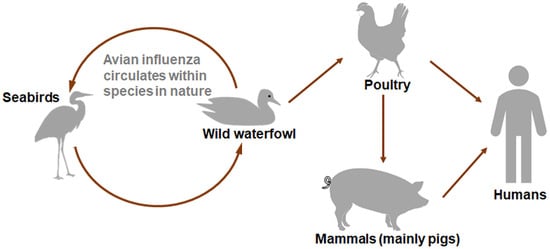
Figure 1
Open AccessArticle
Evaluating a Proprietary Tannin-Blend Product as an Alternative to Monensin and Tylosin Phosphate in Feedlot Cattle Diets
by
Luana D. Felizari, Luke K. Fuerniss, Jonathan L. Beckett, David S. Secrist, Guy D. Hufstedler and Bradley J. Johnson
Vet. Sci. 2025, 12(5), 446; https://doi.org/10.3390/vetsci12050446 - 6 May 2025
Abstract
This study evaluates the effects of a proprietary tannin blend (BX), supplemented with or without sodium monensin (MON), on beef cattle performance, carcass traits, and health. Steers (n = 2986; initial shrunk body weight (SBW) 254 ± 9.2 kg) were allocated into
[...] Read more.
This study evaluates the effects of a proprietary tannin blend (BX), supplemented with or without sodium monensin (MON), on beef cattle performance, carcass traits, and health. Steers (n = 2986; initial shrunk body weight (SBW) 254 ± 9.2 kg) were allocated into 48 pens (61–62 steers/pen; 12 pens/treatment) fed for 230 d. Treatments included: (1) no feed additives (CTL); (2) BX (7.95 g/animal daily); (3) MON + Tylosin phosphate (TYL; 437.52 mg MON/animal daily + 80 mg TYL/animal daily); or (4) MON + BX (437.52 mg MON/animal daily + 7.95 g BX/animal daily). Data were analyzed in R 4.2.1 using a randomized block design with pen as the experimental unit. Dry matter intake was lower (p < 0.001) in MON + TYL and MON + BX than in CTL. Steers fed MON + BX had greater carcass-adjusted final SBW (p = 0.002), average daily gain (p = 0.002), fat thickness (p = 0.035), and marbling score (p = 0.046) than BX. Feed conversion improved in MON + TYL and MON + BX (p < 0.001). CLT and BX had higher (p < 0.001) liver abscess prevalence compared to MON + BX and MON + TYL. The addition of BX did not improve the parameters measured. Steers fed MON + BX showed reduced liver abscesses and similar feed efficiency compared to MON + TYL.
Full article
(This article belongs to the Special Issue Advancing Ruminant Health and Production: Alternatives to Antibiotics)
►▼
Show Figures

Figure 1
Open AccessArticle
Investigating Bacterial Bloodstream Infections in Dogs and Cats: A 4-Year Surveillance in an Italian Veterinary University Hospital
by
Raffaele Scarpellini, Massimo Giunti, Cecilia Bulgarelli, Erika Esposito, Elisabetta Mondo, Fabio Tumietto and Silvia Piva
Vet. Sci. 2025, 12(5), 445; https://doi.org/10.3390/vetsci12050445 - 6 May 2025
Abstract
In small animal practice, blood cultures (BCs) are essential for diagnosing bacterial bloodstream infections (BSIs) and guiding targeted antimicrobial therapy, particularly in relation to the rise of multidrug-resistant (MDR) pathogens. This study analyzed 96 positive BCs from dogs and cats at the Veterinary
[...] Read more.
In small animal practice, blood cultures (BCs) are essential for diagnosing bacterial bloodstream infections (BSIs) and guiding targeted antimicrobial therapy, particularly in relation to the rise of multidrug-resistant (MDR) pathogens. This study analyzed 96 positive BCs from dogs and cats at the Veterinary University Hospital (VUH) of Bologna (2020–2024), assessing bacterial prevalence, antimicrobial resistance, and associated risk factors. Escherichia coli was the most common isolate (29/96), followed by Streptococcus canis (11/96). MDR percentage was 29.2% (28/96), with Gram-negatives associated with higher rates (p = 0.040). Nearly half of the cases (46.9%, 45/96) were suspected healthcare-associated infections (HAIs) significantly associated with the number of invasive devices used (p = 0.008) and with the absence of co-positive samples (p = 0.012). Empirical antibiotic therapy was administered in 94.8% (91/96) of cases, with ampicillin–sulbactam and marbofloxacin as the most used drugs. In vitro empirical therapy appropriateness was 76.9% (70/91). MDR was associated with inappropriate empirical therapy (p < 0.001). Mortality within 30 days was 36.5% (35/96), significantly linked to antibiotic escalation (p = 0.006). The findings highlight the need for systematic BC surveillance in veterinary settings to optimize treatment strategies (especially in countries with restrictions on antibiotic use in animals) to mitigate MDR spread and to protect public health.
Full article
(This article belongs to the Special Issue Bacterial Infectious Diseases of Companion Animals—2nd Edition)
Open AccessArticle
Isolation and Characterization of Porcine Epidemic Diarrhea Virus G2c Strains Circulating in China from 2021 to 2024
by
Xi Lu, Chen Chen, Zixuan Wang and Anding Zhang
Vet. Sci. 2025, 12(5), 444; https://doi.org/10.3390/vetsci12050444 - 6 May 2025
Abstract
Porcine epidemic diarrhea virus (PEDV) is a major pathogen responsible for viral diarrhea in pigs, causing particularly high mortality in neonatal piglets. In recent years, genetic variations in PEDV have resulted in alterations in both its virulence and antigenicity, leading to a reduced
[...] Read more.
Porcine epidemic diarrhea virus (PEDV) is a major pathogen responsible for viral diarrhea in pigs, causing particularly high mortality in neonatal piglets. In recent years, genetic variations in PEDV have resulted in alterations in both its virulence and antigenicity, leading to a reduced efficacy of existing vaccines. In this study, diarrheal samples were collected from four commercial pig farms in the Hubei, Guangxi, and Jiangxi provinces, China, which experienced vaccine failure. RT-qPCR confirmed PEDV infection, and three PEDV strains, 2021-HBMC, 2024-JXYX, and 2024-JXNC, were successfully isolated. Sequence analysis and phylogenetic tree construction classified these strains into the G2c genotype, the predominant subtype in China. The neutralization assays revealed a significant reduction in the neutralizing titers of these strains against the immune serum compared with the AJ1102 reference strain. Further amino acid sequence analysis of the spike (S) protein identified several mutations in key neutralizing epitopes compared with the AJ1102 strain, including S27L, E57A, N139D, M214T, and P229L in the S-NTD epitope; A520S, F539L, K566N, D569E, G612V, P634S, E636V/K in the COE epitope; and Y1376H in the 2C10 epitope, along with several deletions at N-glycosylation sites (347NSSD and 510NITV). Additionally, whole-genome sequencing and recombination analysis indicated that the 2021-HBMC strain may have resulted from a recombination event. The findings of this study underscore the challenge posed by the continuous genetic evolution of PEDV to vaccine efficacy and provide valuable insights for future vaccine development and control strategies.
Full article
(This article belongs to the Special Issue Diagnosis, Epidemiology, and Vaccine Development of Swine Viral Diseases)
►▼
Show Figures
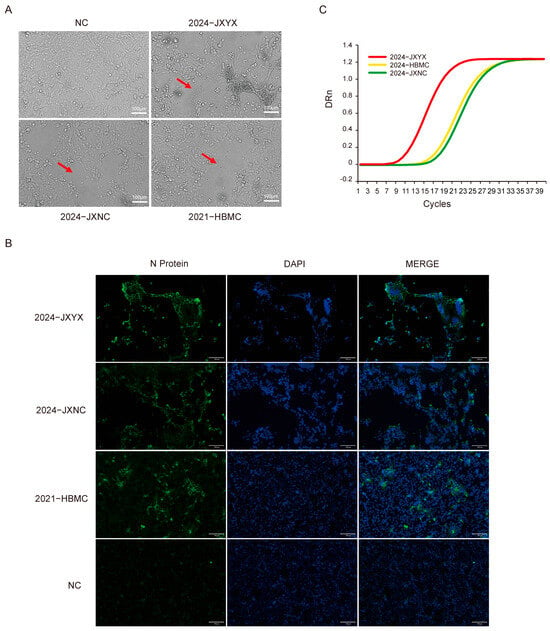
Figure 1
Open AccessArticle
First Report on the Molecular Detection and Characterization of Rickettsia felis in Laelapidae (Acari: Mesostigmata) Mites in Malaysia
by
Hiryahafira Mohamad Tahir, Faraliana Che Lah Ernieenor, Suhaili Zainal Abidin, Vishalani Vishnu Narainasamy and Mariana Ahamad
Vet. Sci. 2025, 12(5), 443; https://doi.org/10.3390/vetsci12050443 - 6 May 2025
Abstract
Rickettsiae are Gram-negative and obligate intracellular bacteria that cause rickettsioses. These pathogens are typically transmitted by arthropod vectors, such as ticks, mesostigmatid mites, and fleas. Rickettsiae are responsible for many emerging infectious diseases worldwide and are the second most frequently reported cause of
[...] Read more.
Rickettsiae are Gram-negative and obligate intracellular bacteria that cause rickettsioses. These pathogens are typically transmitted by arthropod vectors, such as ticks, mesostigmatid mites, and fleas. Rickettsiae are responsible for many emerging infectious diseases worldwide and are the second most frequently reported cause of non-malarial febrile illnesses in Southeast Asia. However, in Malaysia, studies on the prevalence and distribution of rickettsiae have primarily focused on humans, with limited data on these bacteria in vectors and small mammal hosts. Thus, this study aims to investigate the presence of Rickettsia spp. in small mammals and their associated mesostigmatid mites collected from potential rickettsioses areas in Selangor. Animal trapping was conducted across three different ecological study sites comprising a recreational area, agricultural land, and coastal area. A total of 41 small mammals and 363 mesostigmatid mites were collected and identified. Ten percent of the total individual mites were processed for morphological examination, and the remaining mites were then pooled by hosts, with five individual mites per tube, for DNA extraction. The collected samples, comprising blood, animal tissue, and pooled mites, were subjected to DNA extraction and were screened for Rickettsia spp. via nested polymerase chain reaction (PCR), targeting the citrate synthase-encoding gene (gltA) and outer membrane protein B gene (ompB). Interestingly, two pools (3.33%) of Laelaps spp. recovered from Maxomys whiteheadi and Bandicota indica, collected from a recreational area, tested positive for Rickettsia spp. Sequence analysis and phylogenetic tree of the ompB gene revealed the presence of Rickettsia felis in both laelapid mite pools. To our knowledge, this study provides the first molecular detection of R. felis in Laelaps spp. in Malaysia.
Full article
(This article belongs to the Special Issue Molecular Characterization of Various Viruses and Bacteria in Small Animals)
►▼
Show Figures

Figure 1
Open AccessArticle
The Role of Prebiotic and Herbal Supplementation in Enhancing Welfare and Resilience of Kenguri Sheep Subjected to Transportation Stress
by
Veerasamy Sejian, Chinnasamy Devaraj, Chikamagalore Gopalakrishna Shashank, Mullakkalparambil Velayudhan Silpa, Artabandhu Sahoo and Raghavendra Bhatta
Vet. Sci. 2025, 12(5), 442; https://doi.org/10.3390/vetsci12050442 - 5 May 2025
Abstract
A study was conducted to assess the efficacy of prebiotic and herbal supplements to relieve transportation stress based on changes in physiological, hematological, and molecular responses in Kenguri sheep. Thirty healthy female sheep were randomly divided into three groups: a control group (CKS)
[...] Read more.
A study was conducted to assess the efficacy of prebiotic and herbal supplements to relieve transportation stress based on changes in physiological, hematological, and molecular responses in Kenguri sheep. Thirty healthy female sheep were randomly divided into three groups: a control group (CKS) with no supplementation, a prebiotic supplementation group (PKS), and an herbal supplementation group (HKS). The animals were transported 230 km over seven hours during summer conditions, with temperatures ranging from 32.5 °C to 34.9 °C. The groups that received the prebiotic (75.6 breaths/min; 64.8 beats/min) and herbal supplementation (31.0 breaths/min; 66.8 beats/min) had a significantly reduced respiration rate (RR) and pulse rate (PR) compared to those of the control group (38.7 breaths/min; 75.6 beats/min) (p < 0.01 and p < 0.05, respectively), indicating improved physiological stability. The hemoglobin (HGB) and hematocrit (HCT) levels were also significantly lower in the PKS (24.2 g/dL; 24.8%) and HKS (24.7 g/dL; 24.5%) groups than in the CKS (28.1 g/dL; 24.9%) (p < 0.05), highlighting the mitigation of hematological stress. Further, the plasma glucose level was significantly higher (p < 0.01) in the HKS group (80.0 mg/dL) compared to the CKS group (63.5 mg/dL). However, rectal temperature (RT) and skin temperature (ST), red blood cells (RBCs), mean corpuscular volume (MCV), and white blood cells (WBCs) showed no significant differences among the groups. These findings demonstrate that prebiotic and herbal supplementation can effectively reduce transportation-induced stress in Kenguri sheep, offering a practical strategy to improve the welfare and resilience of livestock under challenging environmental conditions.
Full article
Open AccessArticle
Impact of Curcumin on Frozen Bovine Sperm Quality and In Vitro Bovine Oocyte Maturation
by
Hao Lin, Zhiye Hu, Yang Li, Yingchun Li, Wenao Ma, Shoujie Zheng, Jianye Zhou, Zhihui Zhao, Shangquan Gan, Zhibao Chen and Namula Zhao
Vet. Sci. 2025, 12(5), 441; https://doi.org/10.3390/vetsci12050441 - 5 May 2025
Abstract
This study aimed to analyze the effect of curcumin on the antioxidant properties and fertility of freeze–thawed bovine spermatozoa and bovine oocytes. In this study, curcumin concentrations of 0, 5, 10, 25, and 50 µM were added bovine sperm cryopreservation solution and oocyte
[...] Read more.
This study aimed to analyze the effect of curcumin on the antioxidant properties and fertility of freeze–thawed bovine spermatozoa and bovine oocytes. In this study, curcumin concentrations of 0, 5, 10, 25, and 50 µM were added bovine sperm cryopreservation solution and oocyte IVM medium to assess sperm quality, antioxidant properties, oocyte maturation, IVF rate, and embryonic development. The results demonstrated that adding curcumin to the cryopreservation solution significantly improved the viability, motility, and acrosome integrity of bull sperm after freezing and thawing (p < 0.05). The addition of 25 µM curcumin resulted in the best sperm quality. Analysis of antioxidant capacity showed that 25 µM curcumin significantly increased the activities of MMP and antioxidant enzymes, such as CAT, SOD, and GSH-PX, and lowered the levels of MDA and ROS (p < 0.05). Adding curcumin to the in vitro maturation medium notably enhanced the maturation rate and decreased DNA fragmented nuclei of bovine oocytes (p < 0.05), with optimal outcomes observed at 25 and 50 µM curcumin. Totals of 25 and 50 µM curcumin markedly elevated GSH and MMP (p < 0.05), reduced ROS and malondialdehyde concentrations (p < 0.05), and significantly enhanced fertilization rates and blastocyst formation (p < 0.05). In conclusion, incorporating curcumin into both the bovine semen cryopreservation solution and the oocyte IVM medium significantly improved the quality of frozen–thawed sperm, antioxidant activity, oocyte maturation, IVF rate, and embryonic development.
Full article
(This article belongs to the Special Issue Sperm Biotechnology in Animals Reproduction)
►▼
Show Figures
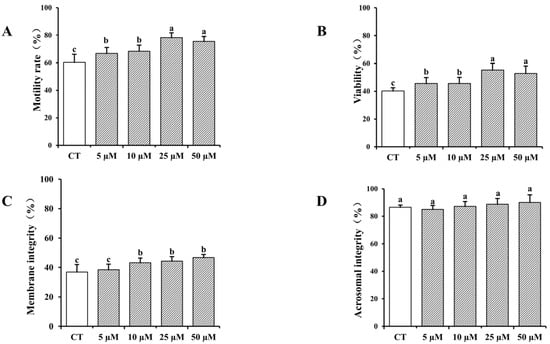
Figure 1
Open AccessArticle
Parity-Associated Differences in the Antioxidants and Fecal Microbiota of Bactrian Camels
by
Hongxi Du, Jianxiong Xu, Hongcai Zhang, Jianjun Li, Fei Wang, Huan Li, Sarula Han, Jiri Gala and Jilite Wang
Vet. Sci. 2025, 12(5), 440; https://doi.org/10.3390/vetsci12050440 - 3 May 2025
Abstract
►▼
Show Figures
Camels survive in deserts through unique, adapted metabolic and immunological processes that are normally lethal to other species. Antioxidants and the gastrointestinal microbiota play major roles in redox homeostasis, yet they remain unexplored in camels to date. The objectives of this study were
[...] Read more.
Camels survive in deserts through unique, adapted metabolic and immunological processes that are normally lethal to other species. Antioxidants and the gastrointestinal microbiota play major roles in redox homeostasis, yet they remain unexplored in camels to date. The objectives of this study were to characterize the dynamics of milk antioxidants, serum antioxidants, and the fecal microbiome of lactating Bactrian camels with different parities. In total, 30 lactating camels were selected and categorized into the following 3 groups: 10 were assigned to the first parity group (P_1), 10 were classified into the third parity group (P_3), and 10 belonged to the fifth parity group (P_5). The antioxidant parameters of the lactating camels were determined in milk and serum. The fecal microbial community of lactating camels was assessed using 16S rRNA amplicon sequencing, and the resulting library was sequenced on an Illumina NovaSeq platform. The amount of total antioxidant capacity (T-AOC) and antioxidant activity for polypepetides (DPPH) in the third parity was the highest among the groups both in the camel milk and its serum. In the case of hydroxyl radical (OH) and SOD, the amounts were 9.62 U/mL (SEM = 0.4950) and 13.64 U/mL (SEM = 0.5144), respectively, for P_1 in the serum, which were extremely significantly greater than those of the other groups. The Shannon index was significantly different between the P_1 group and either the P_3 or P_5 group. Additionally, Simpson’s diversity index significantly differed between the P_1 group and the P_5 group. Furthermore, the number of OH in camels is positively associated with the metabolic pathway of non-oxidative pentose phosphate pathway and ANAGLYCOLYSIS-PWY. In conclusion, this study revealed that different parities were associated with distinct levels of antioxidant parameters and fecal microbial ecologies in lactating Bactrian camels, where parity affects metabolic and microbial health. Understanding these dynamics in camels could optimize their nutritional management, enhancing their welfare in challenging environments.
Full article
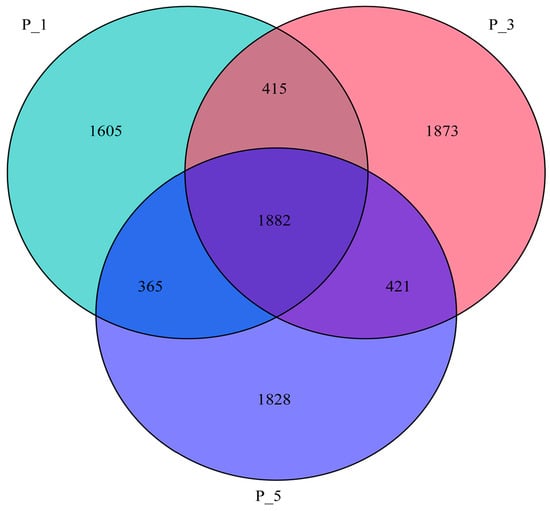
Figure 1
Open AccessArticle
Kinesiology Taping Does Not Affect Tarsal Joint Motion During Selected Exercises in Dogs
by
Rebecca C. Noel, Leann M. Shaw, Nicholas H. Millis, Krysta Janas and Darryl L. Millis
Vet. Sci. 2025, 12(5), 439; https://doi.org/10.3390/vetsci12050439 - 3 May 2025
Abstract
Background: Use of kinesiology taping has increased in veterinary medicine, yet there are few studies of its effects. The purpose of this study was to evaluate the effect of kinesiology tape placed on the dorsal surface of the tarsus on kinetic and kinematic
[...] Read more.
Background: Use of kinesiology taping has increased in veterinary medicine, yet there are few studies of its effects. The purpose of this study was to evaluate the effect of kinesiology tape placed on the dorsal surface of the tarsus on kinetic and kinematic gait characteristics while performing selected exercises in dogs using 3D motion capture and force platform analysis of gait. Methods: Ten clinically normal, healthy, adult mixed-breed dogs were recruited for this study. Reflective markers were applied to the skin of the left and right pelvic limbs of each dog. Eight infrared cameras were positioned around a 13 m platform containing a force platform. Dogs were walked, trotted, and led over cavaletti rails with and without kinesiology tape extending from the distal tibia, crossing the cranial surface of the tarsus, and extending to the dorsal surface of the metatarsals. The evaluations were repeated 2 h later. Maximum flexion and extension in the sagittal plane and maximum angular acceleration and velocity were measured at the tarsus and stifle for each dog. Peak vertical (ZPeak), braking (YA), and propulsion (YB) forces were determined as a percentage of body weight while walking and trotting. Results: Ground-reaction forces were greater at the trot compared to the walk, and stifle and tarsal flexion were greater with stepping over cavaletti rails as compared to walking and trotting. There were no differences in kinematic or kinetic measurements related to the kinesiology tape application, time, or exercise being performed. Conclusions: Kinesiology tape had no effect on tarsal joint gait characteristics while walking, trotting, or stepping over cavaletti rails when applied to the dorsal tarsus of normal dogs.
Full article
(This article belongs to the Special Issue Advanced Therapy in Companion Animals—2nd Edition)
►▼
Show Figures
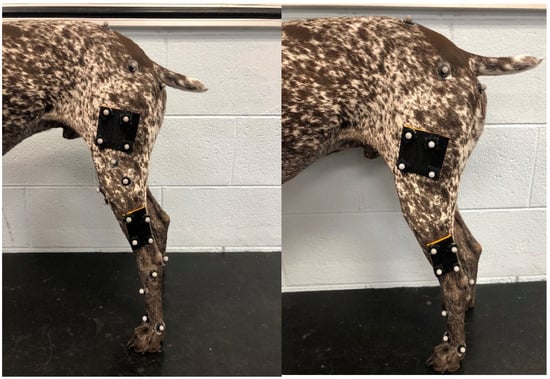
Figure 1
Open AccessArticle
Variations in Intestinal Microbiota Among Three Species in the Cervidae Family Under the Same Feeding Conditions
by
Yichen Wang, Minghui Shi, Jiahui Wu, Xiangyu Han, Mengqi Li, Yining Wu, Yuanlin Jiang, Haonan Zhang, Shuqiang Liu and Defu Hu
Vet. Sci. 2025, 12(5), 438; https://doi.org/10.3390/vetsci12050438 - 3 May 2025
Abstract
►▼
Show Figures
The breeding of large animals in the family Cervidae in China contributes to achieving two tasks: restoring the provenance of wild populations and providing raw materials for traditional Chinese medicine. Currently, red deer (Cervus elaphus), sika deer (C. nippon),
[...] Read more.
The breeding of large animals in the family Cervidae in China contributes to achieving two tasks: restoring the provenance of wild populations and providing raw materials for traditional Chinese medicine. Currently, red deer (Cervus elaphus), sika deer (C. nippon), and white-lipped deer (C. albirostris) maintain a large number of breeding populations. Some studies on the relationship between the intestinal microbiota and the feed of these deer have been conducted; however, owing to differences in feeding conditions between studies, it has been impossible to compare the intestinal microecology and related adaptability between species. Therefore, the present study is aiming to investigate whether the differences in intestinal microbiota of the three deer species are related to the distance of phylogenetic relationships under the same feeding environment. On this basis, we discuss whether there are differences in the adaptability of the intestinal microbiota of the three deer species to feed nutrients, deepen the understanding of the relationship between the three deer intestinal microbiota and feed nutrition, and provide basic data for improving the scientific feeding of the three deer species. In this study, 16S rRNA high-throughput sequencing technology was utilized to analyze the intestinal microbiota in feces of the abovementioned healthy deer species. The results of this study indicated that the intestinal microbiota diversity and relative abundance in female white-lipped deer (FWLD) were significantly lower than those in female sika deer (FSD) and female red deer (FRD; p < 0.05); however, there was no significant difference between the latter two groups (p > 0.05). The community compositions of the intestinal microbiota in FSD and FRD were more similar, whereas that of FWLD was significantly different from those of the first two groups. Firmicutes and Bacteroidetes were the most abundant phyla in the intestinal microbiota of all three deer species, and Ruminococcceae_UCG-005 was the most abundant genus. No known obligatory pathogenic bacteria were observed in any sample. The relative abundance of the operational taxonomic units Christensenellaceae_R-7_group, Treponema_2, and Akkermansia exhibited significant differences among FSD, FRD, and FWLD, respectively. Therefore, the phylogenetic relatedness of the three deer species appears to play a major role in their intestinal microecology under the same feeding conditions—the greater the phylogenetic relatedness between hosts, the more similar is their intestinal microbiota. In addition, the PICRUSt (Phylogenetic Investigation of Communities by Reconstruction of Unobserved States) function prediction results indicated that FSD were less capable than FRD and FWLD in the functional category of nutrient metabolism, and FWLD were less capable than FSD and FRD in the functional category of intestinal absorption. These results indicated that there may be differences in the nutritional adaptation abilities of the three deer species under different feeding conditions. In summary, these results revealed the differences in intestinal microbiota among the three deer species under the same food conditions, indicating that the intestinal microbiota of the three deer species had significant differences in food adaptation. Based on this, the nutritional supply of feed for the three deer should consider the species differences.
Full article
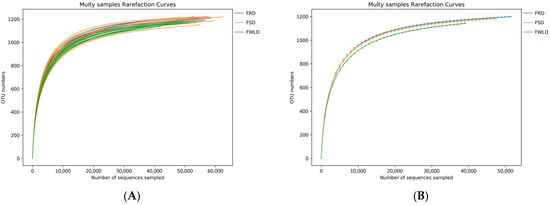
Figure 1

Journal Menu
► ▼ Journal Menu-
- Veterinary Sciences Home
- Aims & Scope
- Editorial Board
- Reviewer Board
- Topical Advisory Panel
- Instructions for Authors
- Special Issues
- Topics
- Sections & Collections
- Article Processing Charge
- Indexing & Archiving
- Editor’s Choice Articles
- Most Cited & Viewed
- Journal Statistics
- Journal History
- Journal Awards
- Conferences
- Editorial Office
Journal Browser
► ▼ Journal BrowserHighly Accessed Articles
Latest Books
E-Mail Alert
News
Topics
Topic in
Agriculture, Animals, Fermentation, Microplastics, Veterinary Sciences
Livestock and Microplastics
Topic Editors: Sonia Tassone, Beniamino T. Cenci-GogaDeadline: 20 May 2025
Topic in
Animals, Antioxidants, Veterinary Sciences, Agriculture
Feeding Livestock for Health Improvement
Topic Editors: Hui Yan, Xiao XuDeadline: 30 May 2025
Topic in
Animals, Dairy, Microorganisms, Veterinary Sciences, Metabolites, Life, Parasitologia
The Complexity of Parasites in Animals: Impacts, Innovation, and Interventions
Topic Editors: Kun Li, Rongjun Wang, Ningbo Xia, Md. F. KulyarDeadline: 31 August 2025
Topic in
Animals, Fishes, Veterinary Sciences
Application of the 3Rs to Promote the Welfare of Animals Used in Scientific Research and Testing
Topic Editors: Johnny Roughan, Laura CalvilloDeadline: 20 September 2025

Conferences
Special Issues
Special Issue in
Veterinary Sciences
Impact of Nutritional Strategies on Weaned Pigs’ Growth Performance and Systemic and Intestinal Health
Guest Editors: Xianren Jiang, Vera PerriconeDeadline: 12 May 2025
Special Issue in
Veterinary Sciences
Spotlight on Cattle Infectious Diseases
Guest Editor: Aizhen GuoDeadline: 15 May 2025
Special Issue in
Veterinary Sciences
Antimicrobial Compounds as Potential Veterinary Drugs and Their Effectiveness Assessment
Guest Editors: Fei Xu, Xiaoye LiuDeadline: 20 May 2025
Special Issue in
Veterinary Sciences
Viral Infections in Wild and Domestic Animals
Guest Editor: Chrissy EckstrandDeadline: 20 May 2025
Topical Collections
Topical Collection in
Veterinary Sciences
One-Health Approach to Bee Health
Collection Editors: Giovanni Cilia, Antonio Nanetti











